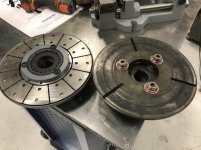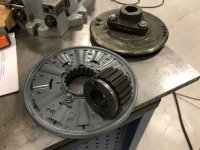I ask as a month or two back I removed the Warner electromagnetic brake from my 135 spindle motor .and was amazed at the difference without it. Night and day difference.. I never realized how smooth and quiet the 135 could be....every noise I always assumed was normal gear or variator noise was actually coming from that brake armature rattling as it rotated. In reality there is NO gear noise and NO variatior noise...just the swish of air from variator and spindle rotation !
Still, as I don't have the lever type collet change attachment but rather the conventional screw tube type, even in back gear, one can rotate the spindle a bit when tightening a collet very tight. So I figured maybe I should explore a better brake. Over months I gradually collected via eBay at cheap prices the critical three NOS parts needed for the "heavy duty" version of the Warner brake, where the armature moves on a spline rather than on three small shafts.
On Monday I finally got around to crawling in the lathe and installing the new spline style of armature. The results were a definite improvement over
the original....but now the issue was not so much increased noise as it was vibration, which I could feel touching the headstock and hand levers, where they was none when it was brakeless.
I thought about trying to remove the brake and perhaps better balancing it but then find out they are supposedly dynamically balanced at the factory anyway (although I see no evidence of added weights or drill holes anywhere on it) so I figure even if I improved it balance wise there would still be no way the lathe would be as perfect as it is with no brake.
Anyhow, as I can see a way to create a spindle lock to solve the collet issue, and the lathe comes to a stop just fine without a brake, just wondering if I am missing any scenarios where an electromagnetic brake would be desirable ? With it, the spindle would stop from 3000 RPM instantly.....but so what ? It stops without a brake from 3000 RPM in 2 or 3 seconds.....I can live with that. (that's with a collet in there however and suspect with a 3 jaw chuck it would rotate a bit longer...need to check that)
So, am I missing anything ?
Still, as I don't have the lever type collet change attachment but rather the conventional screw tube type, even in back gear, one can rotate the spindle a bit when tightening a collet very tight. So I figured maybe I should explore a better brake. Over months I gradually collected via eBay at cheap prices the critical three NOS parts needed for the "heavy duty" version of the Warner brake, where the armature moves on a spline rather than on three small shafts.
On Monday I finally got around to crawling in the lathe and installing the new spline style of armature. The results were a definite improvement over
the original....but now the issue was not so much increased noise as it was vibration, which I could feel touching the headstock and hand levers, where they was none when it was brakeless.
I thought about trying to remove the brake and perhaps better balancing it but then find out they are supposedly dynamically balanced at the factory anyway (although I see no evidence of added weights or drill holes anywhere on it) so I figure even if I improved it balance wise there would still be no way the lathe would be as perfect as it is with no brake.
Anyhow, as I can see a way to create a spindle lock to solve the collet issue, and the lathe comes to a stop just fine without a brake, just wondering if I am missing any scenarios where an electromagnetic brake would be desirable ? With it, the spindle would stop from 3000 RPM instantly.....but so what ? It stops without a brake from 3000 RPM in 2 or 3 seconds.....I can live with that. (that's with a collet in there however and suspect with a 3 jaw chuck it would rotate a bit longer...need to check that)
So, am I missing anything ?





